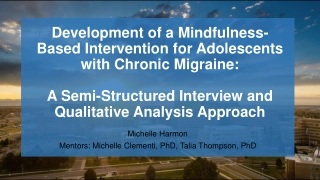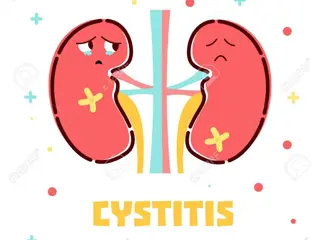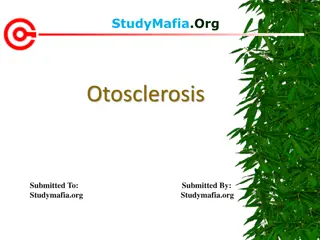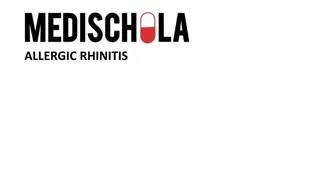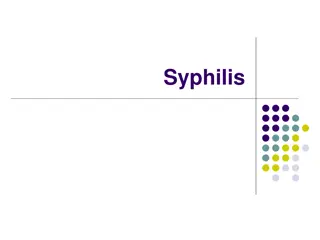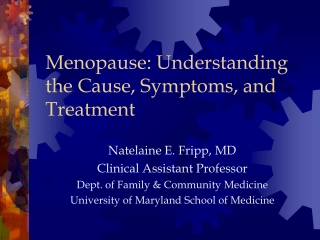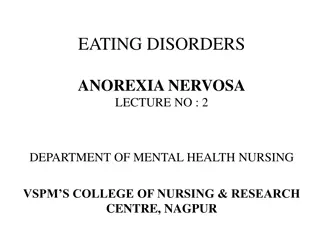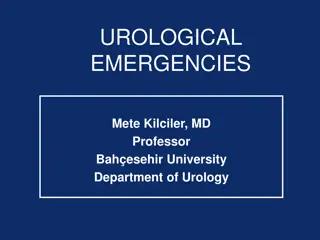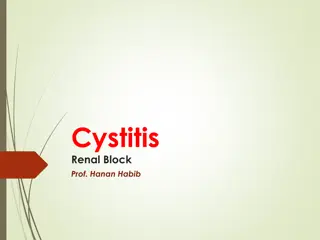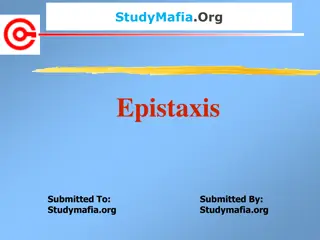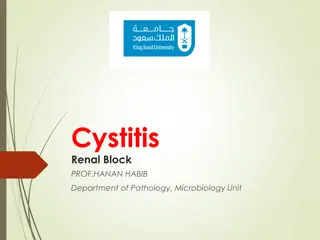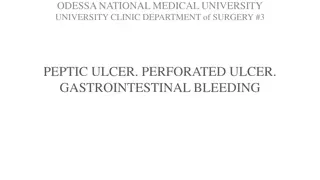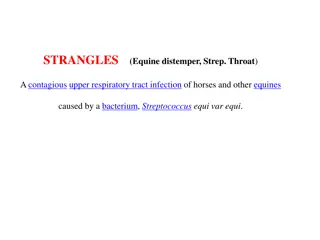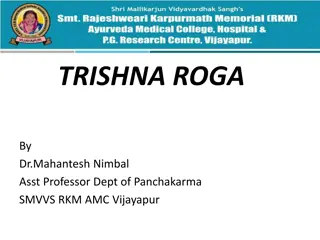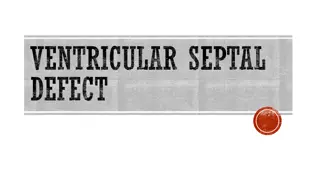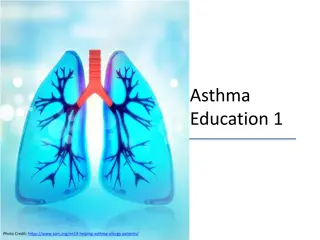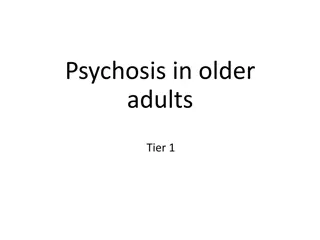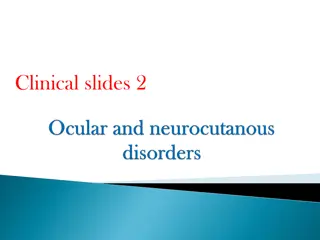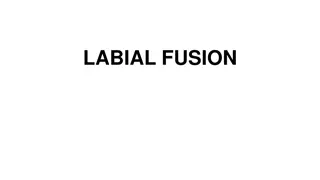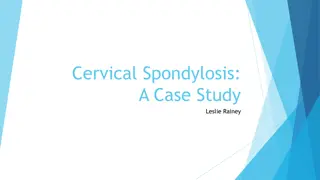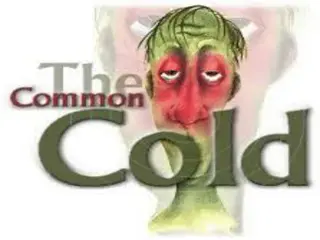Understanding Migraine: Causes, Symptoms, and Treatment Options
Migraine is a complex neurological condition characterized by recurrent headaches, often accompanied by other symptoms such as nausea, sensitivity to light and sound, and visual disturbances. This comprehensive guide delves into the various types of migraines, including those with aura and hemiplegic migraines, along with associated complications and possible triggers. Explore the pathogenesis of migraines, involving changes in neuronal activity, neurotransmitter fluctuations, and trigeminovascular system disturbances. Discover how craniovascular nerve fibers and vasoactive neuropeptides play a role in migraine physiology.
Download Presentation

Please find below an Image/Link to download the presentation.
The content on the website is provided AS IS for your information and personal use only. It may not be sold, licensed, or shared on other websites without obtaining consent from the author. Download presentation by click this link. If you encounter any issues during the download, it is possible that the publisher has removed the file from their server.
E N D
Presentation Transcript
Az elsdleges fejfjsokrl a kutats s terpia leg jabb eredm nyeinek t kr ben: Bozsik Gy rgy 2021.X.13. 1.1 Migraine without aura 1.2 Migraine with aura 1.2.1 Migraine with typical aura 1.2.1.1 Typical aura with headache 1.2.1.2 Typical aura without headache 1.2.2 Migraine with brainstem aura 1.2.3 Hemiplegic migraine 1.2.3.1 Familial hemiplegic migraine (FHM) Els dleges fejf j sok oszt lyoz sa 2018 19/CACNA1A 1.2.3.1.1 Familial hemiplegic migraine type 1 (FHM1) The Primary Headaches 1. Migraine 2. Tension-type headache 3. Trigeminal autonomic cephalalgias 4. Other primary headache disorders 1/ATP1A2 1.2.3.1.2 Familial hemiplegic migraine type 2 (FHM2) 2/SCN1A 1.2.3.1.3 Familial hemiplegic migraine type 3 (FHM3) 1.2.3.1.4 Familial hemiplegic migraine, other loci 1.2.3.2 Sporadic hemiplegic migraine 1.2.4 Retinal migraine The Secondary Headaches 5. Headache attributed to trauma or injury to the head and/or neck 6. Headache attributed to cranial and/or cervical vascular disorder 7. Headache attributed to non-vascular intracranial disorder 8. Headache attributed to a substance or its withdrawal 9. Headache attributed to infection 10. Headache attributed to disorder of homoeostasis 11. Headache or facial pain attributed to disorder of the cranium, neck, eyes, ears, nose, sinuses, teeth, mouth or other facial or cervical structure 12. Headache attributed to psychiatric disorder Painful Cranial Neuropathies,Other Facial Pain and Other Headaches 13. Painful lesions of the cranial nerves and other facial pain 165 14. Other headache disorders 1.3 Chronic migraine 1.4 Complications of migraine 1.4.1 Status migrainosus 1.4.2 Persistent aura without infarction 1.4.3 Migrainous infarction 1.4.4 Migraine aura-triggered seizure 1.5 Probable migraine 1.5.1 Probable migraine without aura 1.5.2 Probable migraine with aura 1.6 Episodic syndromes that may be associated with migraine 1.6.1 Recurrent gastrointestinal disturbance 1.6.1.1 Cyclical vomiting syndrome 1.6.1.2 Abdominal migraine 1.6.2 Benign paroxysmal vertigo 1.6.3 Benign paroxysmal torticollis
Migrn aura nlkl n 5 A) Migr n prevalencia: tlagosan : N k: F rfi: N /f rfi ar ny 12% 18% 6% 3/1 B) 4 - 72 ra C) 1. 2. 2/4 3. ++ / +++ / 4. Fejf j s lettartam-prevalenci ja 67% D) 1. Migr n diagnosztikus krit riumok: Migr n ves prevalencia: aura n lk li migr n 7,6% aur val j r migr n 2% 1/2 2. - A,B, s E pont teljes l se mellett A migr nesek 63%- nak havi 2-n l t bb rohama volt. - C-b l minimum 2, s E) elt r s n lk l A betegek 15%-a mulasztott a migr n miatt munkanapot. - D-b l minimum 1 felt tel teljes l Orvoshoz migr n miatt 43% fordult. A k rd v szenzitivit sa 53%, pozit v predikt v rt ke 45% volt (aura n lk li migr nre vonatkoz an)
Migrn patogenezis npszeren 3. Az idegsejtek aktivit s nak s a v r raml snak v ltoz sa aura jelens gekhez vezet. 4. Neurotransmitter v ltoz sok az agyburkok ereiben helyileg rt gulatot s a k rnyez sz vetekben neurogen gyullad st eredm nyeznek. 2. V r t raml s v ltoz s s elektromos jelek terjednek az agy m s ter letei fel . 5. A neurogen gyullad s irritalja a trigeminalis rz ideg v gz d seket ami s lyos, l ktet fejf j shoz vezethet. 1. Migr n indul sa a m ly agyi struktur k aktivit s v ltoz s val lehet kapcsolatos.
. Craniovascularis idegrostok - vasoakt v neuropeptidek - migr n Craniovascularis idegrostok localiz ci ja Vasoakt v neuropeptidek/Neurotransmitterek Trigeminalis szenzoros idegrostok Calcitonin gene-related peptide (CGRP) Substance P (SP) Neurokinin A (NKA) Pituitary adenylate cyclase-activating peptide (PACAP) Nitric oxide synthase (NOS) Paraszimpatikus idegrostok Vasoactive intestinal polypeptide (VIP) PACAP Neuropeptide Y (NPY) Acetylcholine NOS Szimpatikus idegrostok Norepinephrine NPY ATP
Migrn kezels -specilis betegcsoportokban: Prevent v/megel z kezel s Migr nesekn l havonta 4 olyan fejf j s nappal, ahol az am gy megfelel roham gy gyszer sem elegend . Akut/roham kezel s Id s betegek: Gyakoribb k z tt k a t neti fejf j s, komorbidit s, gy gyszermell khat s. Ebben a korcsoportban kevesebb irodalmi adat van a migr n kezel sekkel kapcsolatosan. Els vonalbeli gy gyszer: NSAIDs (acetylsalicylic acid, ibuprofen/diclofenac potassium) M sodik vonal: Tript nok El gtelen tript n hat s eset n + gyors hat su NSAIDs Els vonalbeli gy gyszer: Beta blokkol (propranolol, metoprolol,atenolol,bisoprolol) Topiramate Candesartan Gyermekek s serd l k: N luk a migr n t netek n mileg elt rhetnek a feln ttekn l tapasztaltakt l (pl. r videbb tartam). Kisebb gyermekek kezel s ben a sz l knek s az iskol nak kiemelt szerepe van. Az gynyugalom nmag ban is elegend lehet. Ibuprofen alkalmas akut kezel sre s propranolol, amitriptyline vagy topiramate a megel z shez. Harmadik vonal: Dit nok ? Gep ntok ? M sodik vonal: Flunarizine Amitriptyline Sodium valproat H nyinger/h ny s kezel s re: domperidone,metoclopramide Terhes/szoptat n k: Paracetamol haszn lhat akut kezel sre. Lehet leg ker lend a prevent v kezel s. N k - menstru ci s migr n Perimenstru lis prevenci hossz hat s NSAIDs-al vagy tript n-nal. Harmadik vonal: CGRP monoclonalis antitest
kontraindikci First-line medication kontraindik ci First-line medication Atenolol 25 100 mg oral twice daily Acetylsalicylic acid 900 1,000 mg oral Gastrointestinal bleeding, heart failure Bisoprolol 5 10 mg oral once daily 50 100 mg oral twice daily or 200 mg modified-release oral once daily 80 160 mg oral once or twice daily in long-acting formulations NSAIDs Ibuprofen 400 600 mg oral Asthma, cardiac failure, Raynaud disease, atrioventricular block, depression Diclofenac potassium 50 mg oral (soluble) Metoprolol Beta blockers Other simple analgesics (if NSAIDs are contraindicated) Hepatic disease, renal failure Paracetamol 1,000 mg oral Propranolol Gastrointestinal bleeding, epilepsy, renal failure, cardiac arrhythmia Domperidone 10 mg oral or suppository Angiotensin II-receptor blocker Co-administration of aliskiren Antiemetics (when necessary) Candesartan 16 32 mg oral per day Parkinson disease, epilepsy, mechanical ileus Nephrolithiasis, pregnancy, lactation, glaucoma Metoclopramide 10 mg oral Anticonvulsant Topiramate 50 100 mg oral daily Second-line medication Second-line medication 50 or 100 mg oral or 6 mg subcutaneous or 10 or 20 mg intranasal Age <6 years, heart failure, co-administration with monoamine oxidase inhibitors and SSRIs, glaucoma Parkinsonism, depression Liver disease, thrombocytopenia, female and of childbearing potential Sumatriptan Tricyclic antidepressant Amitriptyline 10 100 mg oral at night 2.5 or 5 mg oral or 5 mg intranasal Zolmitriptan Cardiovascular or cerebrovascular disease, uncontrolled hypertension, hemiplegic migraine, migraine with brainstem aura Calcium antagonist Flunarizine 5 10 mg oral once daily Almotriptan 12.5 mg oral Triptans Eletriptan 20, 40 or 80 mg oral 600 1,500 mg oral once daily Sodium valproatea Anticonvulsant Frovatriptan 2.5 mg oral Naratriptan 2.5 mg oral Third-line medication 10 mg oral tablet (5 mg if treated with propranolol) or 10 mg mouth- dispersible wafers 155 195 units to 31 39 sites every 12 weeks Botulinum toxin OnabotulinumtoxinA Infection at injection site Rizatriptan 70 or 140 mg subcutaneous once monthly Erenumab Hypersensitivity Not recommended in patients with a history of stroke, subarachnoid haemorrhage, coronary heart disease, inflammatory bowel disease, chronic obstructive pulmonary disease or impaired wound healing Third-line medication Co-administration with strong CYP3A4 inhibitors 225 mg subcutaneous once monthly or 675 mg subcutaneous once quarterly 240 mg subcutaneous, then 120 mg subcutaneous once monthly 100 or 300 mg intravenous quarterly Ubrogepant 50, 100 mg oral Gepants Fremanezumab Calcitonin gene-related peptide monoclonal antibodies Hypersensitivity, hepatic impairment Rimegepant 75 mg oral Pregnancy, concomitant use with drugs that are P- glycoprotein substrates Galcanezumab Ditans Lasmiditan 50, 100 or 200 mg oral Eptinezumab Diagnosis and management of migraine in ten steps A.K.Eigenbrodt et al. Nature Reviews Neurology vol.17. p.:501-514 (2021)
Migrn gygyszerek kutats, fejleszts Hat s mechanizmus Kezel s llapot (?) Hat s mechanizmus Kezel s llapot Calcitonin gene-related peptide (CGRP) mechanism antagonist Glutamatergic targets CGRP receptor antagonist (gepant) Olcegepant (638) Phase II NMDA receptor migraine with prolonged aura Ketamine (10) Phase II Phase II* Telcagepant-acute (396) Prevention of aura not headache Telcagepant-preventive (394) Phase II Tonabersat (326, 381) Phase II Rimagepant (561) Phase II Phase II* AMPA/kainate Tezampanel/LY293558 (704) Phase II BI44370TA (216) iGluR5 (kainate) receptor LY466195 (448) Phase II MK-3207 (391) Phase II mGluR5 (glurants) ADX10059 (839) Phase II Ubrogepant (828) Phase II AMPA receptor antagonist BGG492 (353) Phase II (F) Atogepant (AGN-241689) (preventive)+ Phase I Neuroinflammatory targets CGRP antibody (nezumab) Eptinezumab (224) Phase III TRPV1 SB-705498 (165) Phase II (F) Galcanezumab (225) Phase III Substance P/neurokinin-1 Dapitant (218) Phase II (F) Fremanezumab (96, 97) Phase III Lanepitant (351) Phase II (F) CGRP receptor antibody (numab) Erenumab (770) Phase III GR205171 (176) Phase II (F) Serotonin related Fosaprepitant (629) Phase II (F) Serotonin 5-HT1Freceptor agonist (ditan) Lanepitant (349) Prevention Phase II (F) Lasmiditan (260, 267) Phase III Neurogenic plasma protein extravasation (PPE) CP-122,288 (691) Phase II (F) Nitric oxide synthase (NOS) inhibition Pan NOS 546C88 (507) Phase II 4991W93 (233) Phase II (F) Inducible NOS Other targets GW274150 acute (649) Phase II (F) Orexin 1 and 2 receptors (rexants) GW274150 preventive (403) Phase II (F) Fliorexant (150) Phase II (F) Neuronal NOS plus triptan NXN-188 (428, 595) Phase II (F) Angiotensin receptor (?) Candesartan (765, 800) Off-License (F) Telmisartan (219) (F), study failed; *Liver toxicity led to termination of development. +Reported to exist in November 2015 at Allergan R&D Day. [Modified from Goadsby (306).]



